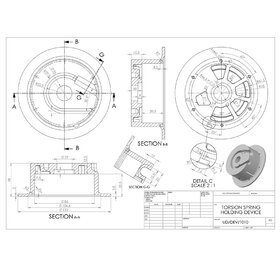
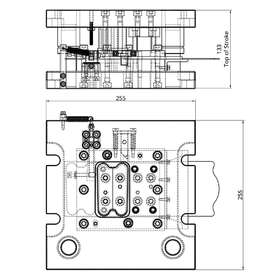
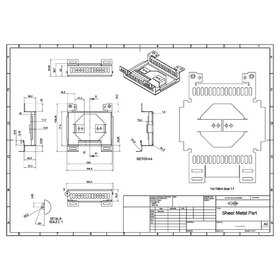
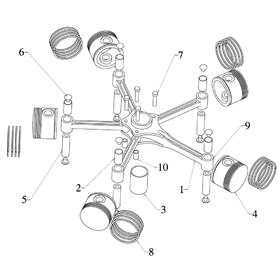
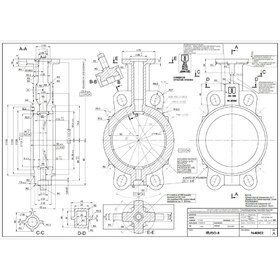
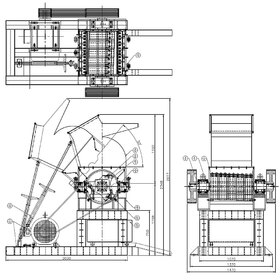
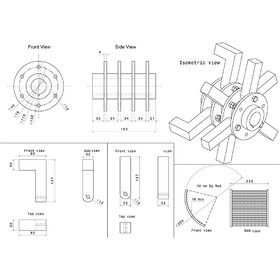







As a rule, drawing is usually thought of as an art form, such as illustration, animation, or even sketching — just think of Picasso’s incredible sketch work. In this sense, drawing is intended to be creative, illustrative of something in the imagination. Drawing requires technical skill, of course, but it also functions as an outlet for creative expression.
The practice of machine drawing does bear some of these characteristics, while it distinguishes itself in other ways. Perhaps the most central difference between illustration and machine drawing is their objective. That is, machine drawing mostly functions as a science like engineering, rather than a means of artistry.
Whenever a company or organization needs to build a machine of any kind, they make use of technical drawings and machine drawing services. People utilize these drawings in many different facets and stages of the production or manufacturing process. The goal, however, remains the same throughout the operation. The objective, of course, is to produce the machine in question as capably and efficiently as possible. In turn, the machine should both appear and function as the engineering services and CAD designers intended it to. Because of this, technical drawings must be rigorous and complete, lacking nothing in the way of specifications or detail.
Given these demands, manufacturers require their technical documents to be drafted by experts in machine drawing. Machine drawing technicians and drafters must communicate clearly and unambiguously. Their drawings need to include everything that is entailed for the machine undergoing fabrication to be constructed by an assembly line or group of machines. Drafting, in this way, is also called “engineering drawing.” Such a phrase might call to mind the more scientific nature of machine drawing over its artistic cousins in illustration or even painting.
As such, machine drawings must also follow whatever industry standards are necessary within a given field. Some standards are local or national, while others are international, such as the International Organization for Standards (ISO). Because of this, it should make no difference which company or country drafted the documents. If such standards are implemented, drawings and drafting documents can be read and interpreted by people all over the world without any difficulty or confusion.
While it is essential that the machine as a whole is communicated plainly and deftly in any and all drafting documentation, the parts of the machine require this same treatment. Machine drawings, then, do not only consider the machine as a whole, but also the many constituent parts that make it up. This is quite literally the “nuts and bolts” of any given machine. Machine drawing technicians draft each component part with the same scientific accuracy and attention to detail as any other part. Precision is the name of the game.
As implied, machine drawings are mostly utilized during the manufacturing phase of a component or machine’s development. Any draft or series of drafts might be employed for designing a machine or any of its parts. These drafts can be employed during the manufacturing of the machine or of any of its finishes or ultimate assembly into a complete and functioning whole.
The information included in machine drawings is required all along the way. At various points, it can be used for setting machines or tools. In other areas, these drafts might be drawn on (no pun intended) for auditing and inspection regarding quality control measures. Even individuals or teams in the service or sales departments might make use of machine drawings for their work. The importance of such machine drawing service documents cannot be overstated.
Everyone involved in the manufacturing of a machine will likely deal with machine drawings at some point. It is nearly unavoidable in manufacturing businesses. That being said, in some cases, there is increased automation from draft to machine.
In these instances, the machine drawings themselves can be translated into a computer that processes the information. This can actually be completed on many occasions without the need for any human intervention or interpretation. Even so, the documents themselves must be perfectly intelligible and unambiguous as always, whether a human or a computer will be doing the reading, interpreting, or rendering.
Ultimately, machine drawings consist of visual depictions, delineations, and demarcations. Machine drawing services must complete all drawings of parts and assemblies in any constructed machine or manufactured contraption. Consider the objects that line the walls, floors, ceilings, and desks of rooms and offices all over the world: dishwashers, hairdryers, refrigerators, ceiling fans, electric motors of any kind, computer and photo printers, even cars and airplanes. All of these need machine drawings to be built and eventually sold on the market. With this in mind, it is quite easy to understand how many industries and fields make use of machine drawing services for their manufacturing needs. (Hint: it’s all of them.)
Machine drawing service technicians need to be highly skilled at the engineering side of a given process. They also require experience and skill with the technical drafting side of the projects on which they work. The actual machine drawing work is most often created using such computer-aided design programs as Autodesk’s AutoCAD drafting and design services. Autodesk also has plenty of other software packages more suited explicitly to distinct industries, such as architecture, patent design, or even 3D rendering. Because of this, Autodesk has become the industry standard in which most machine drawing services work is completed. (Drawings done by hand are another option, albeit far more time-consuming.)
Regardless of how the actual drafts are drawn, there are a few steps that are necessary to achieve the highest quality technical drawings.
To begin, designers, engineers, and draftspeople need to determine which views are most important for the production of the machine itself. This will vary based on the machine, of course. Consumer photo printers will need different drawings than an industrial 3D printer, for example. All technical drawings need to centered on their specific document, leaving room for dimensions to be added whenever necessary. These views might include both external and internal aspects of an apparatus, especially if a particular area is difficult to measure easily. In this case, section views and detail views will probably be required as well.
Further, construction lines will be needed on every view, regardless of the type. These pertain to the center of the drawing, as well as how the planes and lines intersect to indicate symmetry in the machine itself. Construction lines are also used to determine the center of holes or circular patterns on an object. Of course, within all of these steps, dimensions are necessary, with the most essential ones being given priority and top billing. Along with this, size, location, and length of all measurements should be included. Tolerances to any facets that might need greater precision than standard accuracy will allow should also be incorporated into the necessary drafts.
Ultimately, the title block will be filled in with any relevant information and details. Any stipulations that go beyond standard practice, such as the specific finishing of different surfaces. Lastly, any deburring (this is the smoothing out of a rough — usually metal — edge) should be included in the notes to the technical drawings themselves.
As is likely evident given the above description of machine drawings and how work in this field operates, nearly any organization or company using manufacturing in some way can utilize machine drawing services. These drafting documents are mostly employed during the manufacturing process, as discussed earlier. So, it stands to reason that these branches of companies would use them more than any other. That said, higher management would also likely need to sign off on them in many cases, especially with regard to complex (i.e., “costly”) engineering.
Consider just a few examples from the list given above. An electric motor requires many different parts and components to function correctly. In any given electric motor, the primary part is the rotor, which moves and turns the shaft to provide mechanical power. In turn, the rotor quite often has its conductors installed within it that facilitate the passage of air.
This interfaces with still yet other pieces — one which is called the stator — to produce the actual energy that moves the shaft itself. These are just a small handful of the parts necessary for an electric motor construction. One could go on and on, but the point is clear. An electric motor must have a detailed machine drawing to be constructed and operable. Further, each one of the constituent pieces of the electric motor must also have its drafting documents, and expert machine drawing service technicians must execute all this.
To move up the ladder of complexity a bit, consider another example: the car. Cars contain electric motors, of course, which have already been shown to need their machine drawings. Many more pieces and components, however, make up the car as a whole, of course. Every one of these singular parts needs its machine drawings to be constructed and assembled as engineered and intended.
Without such technical drafts, the assembly of a machine, regardless of size or overall complexity, is simply not possible. Humans and computers alike need machine drawings to build and assemble machines and devices of any kind, whether it be an individual motor or an entire car.
Bringing Cad Crowd on board with your machine drawing services project means that you can work with an exclusive group of the world’s greatest freelancers in nearly every engineering or design field in existence. We have a community of technical draftsmen and women, designers, and machine drawing services all over the globe with years of experience working across a wide range of software within a diverse spectrum of businesses. Whatever your patent needs may be, Cad Crowd can help you get exactly where you need to go. We can meet every machine drawing services solution, regardless of project field or scope.
We can help you by utilizing a range of the most updated programs. Our network is made up of the best experts using the highest quality current computer-aided design software. Just let us know if there is a particular application you need us to use, and we will locate the perfect machine drawing services artist, designer, or engineer for your project.
Cad Crowd’s services are at the disposal of clients who currently have drafts or models in-hand and need additional assistance with the task of rendering or further development utilizing a broad range of expert machine drawing services engineers and designers.
Cad Crowd is simply the best place to get everything your machine drawing services project needs researched, designed, drafted, engineered, or rendered. Start working with us today.


